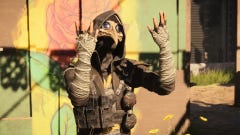Our 24 favourite games of 2022
As voted for by the RPS Treehouse
9. Norco

Alice Bee: It's quite hard to sum up Norco in a pithy, once sentence pitch. Okay, so it's a story-heavy point and click adventure set in an alternate near-future version of Louisiana. You play Kay, recently returned to the small home town you left years before, because you mother has recently died. Only pretty much as soon as you arrive, you find your brother Blake is missing and nobody knows where he's gone. Not any of the locals. Not your semi-illegal live-in robot with a face full of stars. No one.
Things escalate quickly. Almost immediately you discover that you mum was probably involved in some kind of industrial espionage. Your point of view switches between Kay and her mum Catherine, and you discover weird cult-like religions, a shady app, a company that copies people's memories (and you get to select which ones are importat). You take diversions into weird folk tales that sound semi-mythological. It's heightened and weird and increasingly surreal.
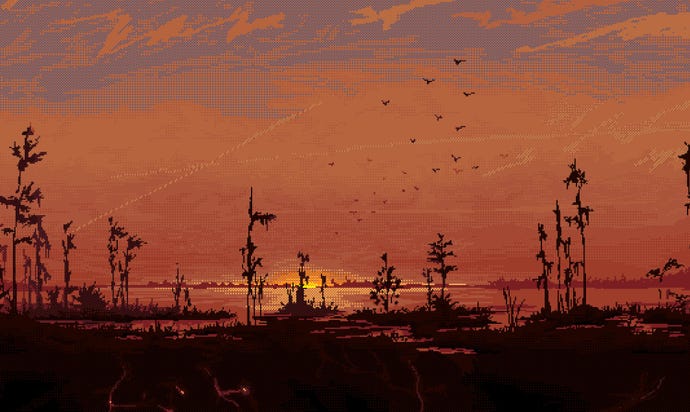
The writing is fantastic, managing to bring you both intimacy as well as vast strangeness. I've never been to Norco, much less Louisiana, but Kay's familiarity with the place in the game became my familiarity, and the ways Norco had changed since she left became jarring to me, too. At the same time, the family drama is woven into a tapestry of huge issues: religion, indentity, self, and a corporation ravaging a community.
All this is underscored by the art, the kind of expressive, dense pixel art that makes you go "woah". Much of Norco is incredibly beautiful, but it can flip on a dime and become ugly or disturbing (the close ups in The Excavation Of Hob's Barrow reminded me of it a bit). It's one of those things that is incredibly specific but makes you think of other cool art you like. Plus, in colliding Southern Gothic and cyberpunk, Norco is merging two of the hottest artistic trends of the year, in a way that is more effective and interesting than most games (or shows, or movies, or books etc.) of either genre I've seen this year.
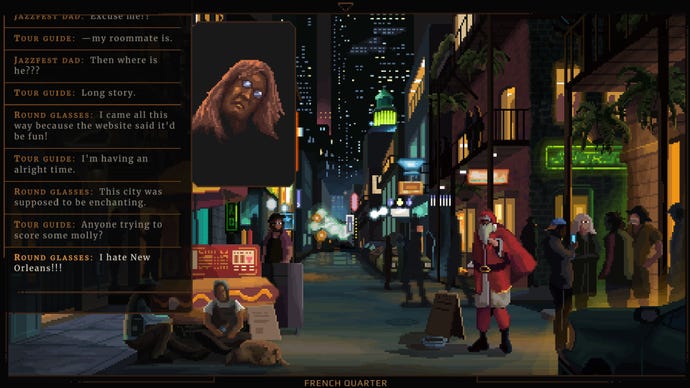
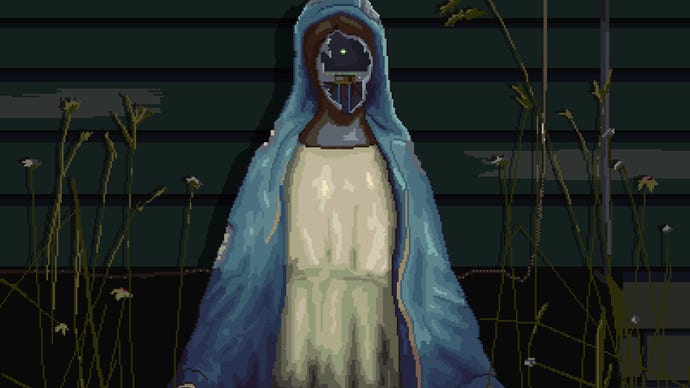
Katharine: Cor, Norco sure does go places, huh? Its initial mysteries of your missing brother and what really happened to your mum were already pretty strong hooks as point and click games go, but man alive, I was not expecting to be transported into the avian hivemind of maybe a semi-conscious AI, nor pulled into a strange cult that's seemingly formed around it. Its stunning vistas still linger in my memory long after finishing the game, and its wistful dialogue easily stands out as some of this year's best games writing. A very special thing indeed.
Alice0: I've not yet finished Norco but I have enjoyed it so far. I should remedy that over the break. It isn't even that long. Shame on me.
Rachel: A much as I love Norco’s writing and slow-burn mystery, it’s the game’s setting that has really stuck with me long after I finished it. This semi-fictionised Norco is nestled in the swamps of southern Louisiana, a place where the air is thick with industrial smoke and the heat sticks to you like a bug on fly paper. It’s a dead-end town on the brink of bankruptcy, sucked dry from the giant oil refinery looming in the locals' back yards. Norco’s story set pieces are not your usual sci-fi set fodder, either. Its weirdos can be found in sweeping swamp lands, faded strip malls, empty parking lots, and dodgy dive bars. Its sinking suburbs are on the brink of being swallowed by both economic and natural disasters and its residents are powerless to stop either from happening. It’s a devastating and an unforgettable backdrop for one the of years best mystery games.
8. Neon White

Alice0: Neon White is a speedrunning FPS set across vaporwave Heaven, where a gang of anime idiot criminals have been raised to defeat demons. Playing as an embarrassing anime idiot, we're trying to climb the leaderboards of Heaven's demon-killers by dashing and shooting through levels as fast as we can. All of the weapons we find scattered about levels offer bonus movement abilities, ranging from air-dashes and double-jumps to rocketing around and high-speed stomps. All you have to do is reach the end and kill all demons along the way. Levels are short, most taking less than one minute—but the real Neon White is trying to complete them much, much faster than that.
Neon White's levels present obvious routes to take. You can score the bronze, silver, and gold medals on each level by following the obvious route, climbing the tiers by meandering less, aiming faster, keeping on the move. The point that Neon White becomes Neon White is when you push into the ace tier and beyond. To score the ace medal, you must not only nail your performance, you must break from the obvious route by finding a new use for a movement ability or questioning the perceived bounds of the level. Skips, tricks, and lightning-fast aiming will get you there. And from there, well, it's easy to fall into chasing the dev medal times, and then chasing the leaderboards.
This is Neon White at its best: seeing beyond what a level appears to be, figuring out your own little tricks, revelling in every split-second shaved, finally nailing a tricky skip, then coming to master that skip and making it another movement performed unconsciously, and celebrating every place climbed on the leaderboards. It is a wonderful feeling to nail a run and set a new best time, yet the feeling that I could do one section just a bit better never goes away. I was very happy to have Neon White levels running in the back of my head for several weeks this year, occasionally throwing up potential solutions that I'd have to dash to my PC to check.
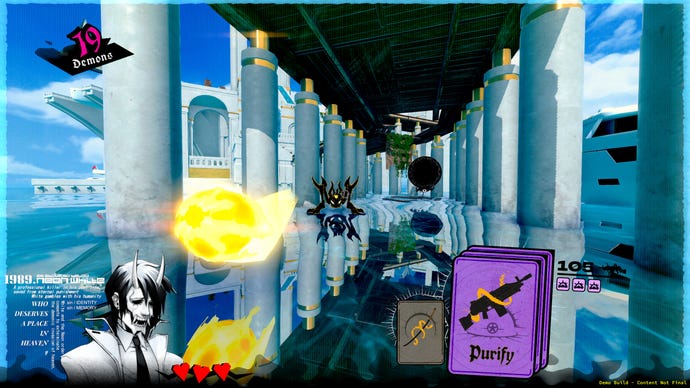

All the while, you're zipping through a beautiful vision of Heaven, listening to fantastic music, and hanging out with your idiot anime pals. I know some find this rude 'tude off-putting but I'm quite fond of these idiots and here for their daft plans.
Logging back into Neon White now, I see our Ollie has beat some of my leaderboard times by as little as 4 milliseconds. God damn it. Alright, I must now go try to reclaim these positions.
Liam: I've only played a few hours of Neon White (and enjoyed it a lot!) but it's the soundtrack that's stuck with me more than the game itself. Composed by Machine Girl, these high-intensity beats are a solid pairing for doing boring tasks around the house. Honestly, try hoovering while pumping Glass Ocean into your skull. You'll find yourself doing sick drifts past the coffee table and sliding down the bannisters to try and beat your PB. It's phenomonal.
7. Ghostwire: Tokyo
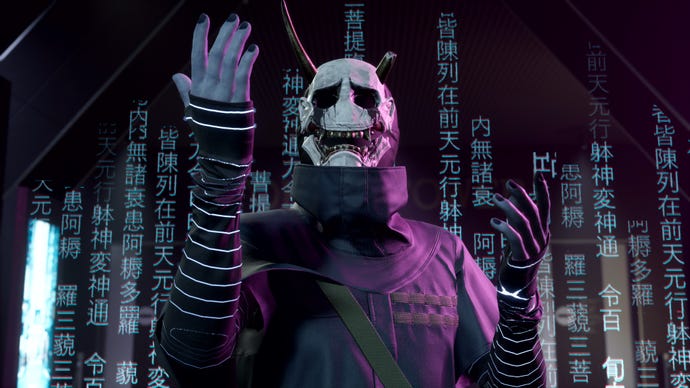
James: Not that it was a New Year’s resolution to change my tastes, but I do feel less inclined towards open world games than I did at the start of 2022. Between a busier schedule and my rekindled fixation on class-based team shooters from 2007, I’m less motivated than ever to traipse across vast lands doing chores for randos. Ghostwire: Tokyo, however, has been a shining exception.
And by shining, I of course mean eerie and rain-soaked. In the aftermath of a paranormal invasion, Ghostwire: Tokyo’s Tokyo has been left as one big liminal space, devoid of anyone save for patrolling yokai and the unsettled spirits of their victims. This emptiness, far from feeling dull, helps realise a brilliantly compelling atmosphere – as does the impeccably detailed rendition of Tokyo itself. I could spend hours poking around its glowing streets, strewn with the clothes of its vanished citizens. And I have.
There’s busywork, sure, but it’s sufficiently spiced up by the richness of Japanese folklore. A simple fetch quest, for instance, becomes a rescue mission to save a zashiki-warashi – a childlike, fortune-bringing household spirit – from that greatest of evils, a landlord. Even upgrading your own set of ghostly powers relies partly on playing a baiting game with the kappa, aquatic turtlemen who steal lifeforce orbs out of people’s bums. Not that video games should ever form the entirety of one’s cultural education, but I got ensconced pretty quickly in this world of tales and monsters that’s rarely touched upon here in the West.
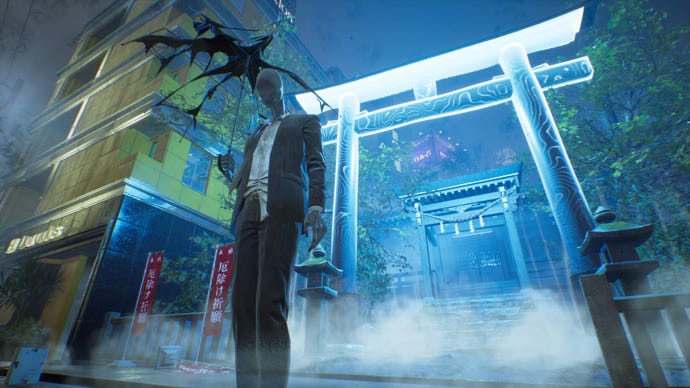
The action is decent, making a charming use of literal finger guns, and as dull as our protagonist is, there’s something quite touching about the blooming bromance between him and the deceased cop co-inhabiting his body. But it’s the city of Tokyo, and the cast of ghoulies within it, that stole my heart like a kappa steals bum balls. Wait, no, hang on.
Rebecca: Ghostwire: Tokyo isn't a scary game, but it is a spooky game. It's an important distinction. I'm definitely one of those anxiety-ridden oddballs who regard horror as their comfort genre, but I prefer a good slow-burn spookening to straight-up running for my life from a chainsaw-wielding zombie. It's not that there's no peril in this game, far from it; but nevertheless, it's a game that feels as though it wants to work with you, not against you. It wants you to walk through the empty city streets together taking in the sights, and while it aims to keep you nicely creeped out, it would hate to strike such fear into your heart that you neglected to have a proper look around.
.jpg?width=690&quality=80&format=jpg&auto=webp)
I had nothing but praise for Ghostwire back in our GOTFHOTY list, and everything I said back then still applies, basically. There are just so many things I love in this game, from the opportunities for digital tourism in a realistically rendered Tokyo — a wanderlusty lifeline when I haven't ventured further afield than North Wales since the start of the pandemic — to the endlessly intriguing enemy designs. The Students of Pain and Misery deserve a special shout-out as my new favourite video game mooks: deeply sinister as they mooch about the streets in their spectral teen gangs, yet somehow still so adorably gawky that I just want to give their cheeks a materteral squishing… except, oops, they don't have faces, do they? Nor heads, even. Best shoot them with my elementally-infused finger guns instead then.
When I last wrote about this game in July I hadn't even unlocked the Summon Tengu ability yet, which is a literal gamechanger, let me tell you. Even without a Tengu at my beck and call, this was a very "just one more" type of game. You know: I'll just do one more quick side-mission, look round one more corner, clear one more cluster of Visitors and cleanse that patch of corruption they're guarding, oh look now there's a new street for me to walk down. Now, with the ability to glide across the city skyline on the wings of my paranormal pals while bypassing the meaner streets of Shibuya, I have to be physically peeled away from this game and reminded to eat. I haven't even finished it, I'm still just so busy sticking my nose into every alleyway to see what's there. (Spoiler: it's ghosts.)
6. Tunic
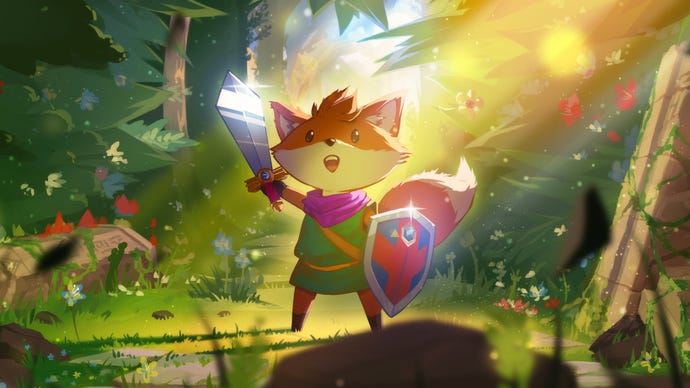
Katharine: After playing and not liking Tunic's demo very much, I went into this very clear Zelda homage with a bit of trepidation. I was sad I didn't get on with that earlier demo, what with Zelda being my favourite thing on the entire planet (sorry, PC), and I was worried that its Soulsian combat would prove too gruelling and off-putting.
Said combat is still utterly rock hard at times (lookin' at you, Siege Engine), but the more I played of Tunic proper, the more I realised that its demo was only a tiny snapshot of a much larger, more engrossing whole. Indeed, it was missing the key ingredient that would eventually go on to make Tunic one of my favourite games of 2022. And that, dear readers, is its wonderfully crafted instruction booklet.
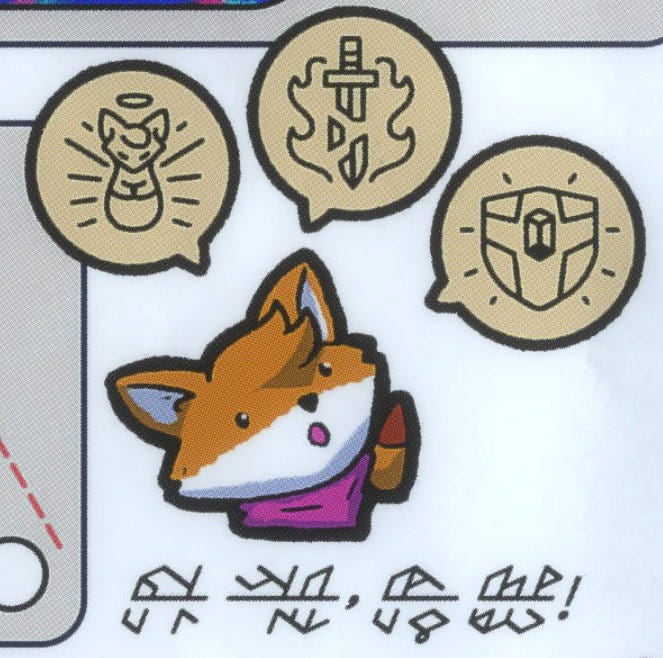
Riffing on old NES manuals of yore (and specifically the one for the secretly second-best Zelda game of all time, Zelda II: The Adventure Of Link, fight me), Tunic's cryptic booklet is pieced together page by page as you explore its mysterious, ruined island. Each page provides vital clues on how you can interact with this imposing, seemingly impenetrable place, but the runic language it's written in constantly holds you at arm's length - arguably, a bit like the rock hard difficulty of actual NES games did back in the 90s. There's no denying that Tunic still asks a lot of its players, both in terms of its action and brain-melting puzzles, but the way everything links back to that all-important booklet and the knowledge contained within is what elevates Tunic far beyond the realms of mere homage. This is a game that captures, riffs and plays on the very concept of nostalgia and that childlike sense of discovery we constantly yearn for in games these days, making it both a fundamental part of the way you navigate its world, and how you approach its mythic conclusion at the end. It's expertly done, and peeling back the layers of its giant, world-spanning puzzle box is an absolute delight.
It's that gradual unfurling of secrets that ended up dominating every waking thought earlier in the year, and cor, when a game infiltrates my brain like that, I just know we're onto a winner. I love a good mystery (which is good, because Tunic has tons of 'em), and when so many of them are teased out through mastering its tough, but fair combat system, ooofta, that's the real sweetspot, that is. Importantly, though, it's not as ridiculously hard as Elden Ring and its oeuvre of Soulslikes. I mean, how can it, when you're accompanied by such a chill, dreamy soundtrack? Simply impossible.
Altogether, I'm so glad I pushed through my earlier demo worries, because lemme tell ya, I'd have missed out on one of my favourite games from the last half decade if I had, and that would have been an absolute tragedy.
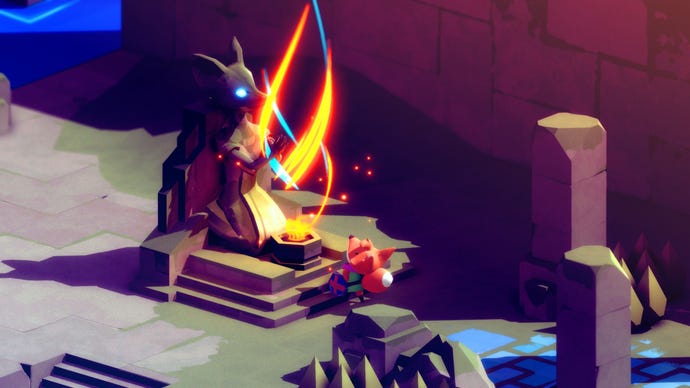
Hayden: Echoing Katharine’s thoughts, Tunic’s instruction manual sure is a tantalising way to tease solutions out of your brain. Or, more accurately, it was when I actually found the bloody pages. I somehow missed a bunch while exploring, so I spent a lot of time sort of stumbling into answers. Sheer force of will pushed me to make progress, and that served me well enough for about half of Tunic’s series of sly puzzles. Eventually, though, I reached a conundrum that I simply couldn’t crack. I’ll be vague for those who have yet to play, but after I collected the three keys and nothing happened, it was time to call in the cavalry.
I was still fairly new to RPS back in March, and vid bud Liam was very new. I’m not great with new people, but I knew he was also playing Tunic for a video. Armed with that knowledge, I started firing questions into his virtual inbox. Those questions turned into shared bemusement at puzzles, and that shared bemusement became thrilled cheers (messages with lots of exclamation marks) when one of us finally found the path forward.
Solving those puzzles might sound arduous, and honestly, they often were. Making your way through Tunic without the manual pages is an incredibly obtuse experience, like trying to find a way out of a conversation with your great great aunt after they’ve asked whether you’re dating during the family Christmas meal.
While it likely wasn’t the intended experience, I’m grateful that Tunic let me go wrong, as that’s what made it feel so nostalgic. Muddling through Tunic alongside Liam was just like sitting with my brother to chip through The Minish Cap or Phantom Hourglass as a kid. We had no idea what we were doing, but figuring it out together was an absolute treat. Tunic trusting me to make mistakes and still find the solution (with lots of help from my pal) made it feel quite special, and proves that something quite lovely can blossom out of two people repeatedly saying “wot the fuk” over messages.
Liam: I maintain that this is the best 2D Zelda game Nintendo never made.






